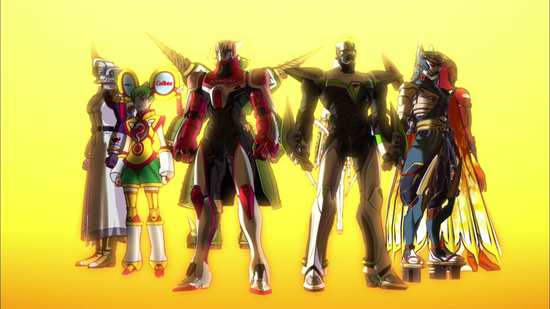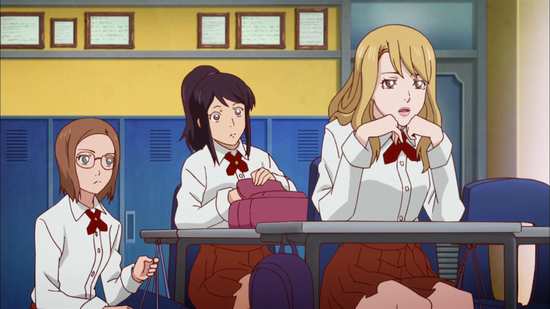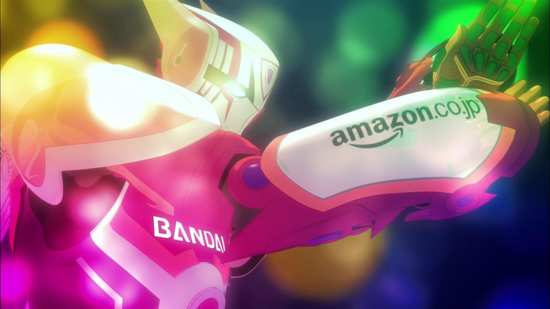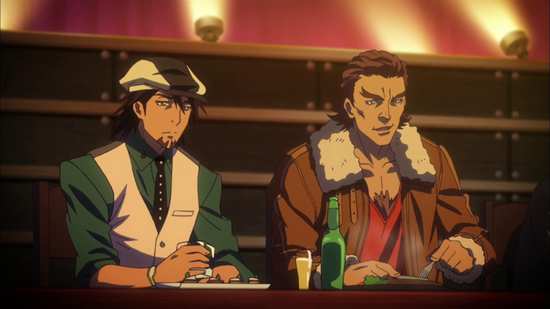Review for Tiger & Bunny Part 3 Blu-ray & DVD Combo Pack
Introduction
Kazé’s Tiger & Bunny gravy train has been derailed somewhat in recent weeks. As I mentioned in the previous review, it hasn’t been helped by both the US and Australia completing their Tiger & Bunny releases in comparatively inexpensive half-season sets, where the UK has only gotten halfway through the series with dearer quarter-season combo releases. But recently it transpired that the first of the Tiger and Bunny spin-off movies has been licensed by Anime Limited, not Kazé. It’s hard to remain enthused about a show when the rest of the world has raced ahead, and to think, it was Kazé that had the head-start when they released their volume 1 first of all. A tortoise and hare simile springs to mind. Hmm, Tortoise and Hare... I think I have an idea for Season 2.
The future has arrived, and with it the superheroes. Some forty years previously, genetic mutations started appearing in people, resulting in them developing strange powers. They were called NEXT, and some of them began using their powers to help people. They became the heroes that stopped crime and kept people safe. Today, in Stern Bild city, heroes are big business and indeed entertainment. Sponsored by major companies, they compete in a game show called Hero TV, trying to rack up as many points as possible as they go about their hero business to be crowned King of the Heroes each year. Of course being telegenic, and knowing just how to make an entrance are important as well.
Not so important to Wild Tiger, a.k.a. Kotetsu Kaburagi who got into the hero business for the old fashioned reason, to help people. He uses his ‘Hundred Power’, an ability that boosts his strengths 100-fold, but only for five minutes, to try and do good, but his enthusiasm usually leaves a lot of property damage in his wake. As a result he tends to slip down the rankings. It gets to the point where his sponsors pull out, and his manager quits. He’s got just one chance to redeem himself, and join a new corporation that is trying something new in the hero game. They’re establishing a hero team, a first for Hero TV, and Kotetsu will be sidekick to the hottest young thing on the block. Barnaby Brooks Jr. has the same powers as Wild Tiger, but that’s where the similarity ends. His approach to the superhero business is diametrically opposed to Kotetsu’s and he’s a lot more business-like and pragmatic in his attitudes. He’s also got a very personal and not at all altruistic reason for becoming a hero. Naturally they wind up butting heads on the first day on the job. They may not be much of a team, but at least the new suits look cool, and as long as Hero TV’s ratings go up, Wild Tiger may just hold onto his job.
Previously on Tiger & Bunny, the bickering duo faced their toughest challenge when Jake Martinez escaped from prison. Since then, Kotetsu and Barnaby are almost working like a well-oiled machine. Ten months have passed and they’re climbing up the rankings, the most popular heroes in Stern Bild. But the murders of his parents aren’t quite as solved as Barnaby thought, while Kotetsu’s life is about to change in a way that will threaten their partnership as never before.
The next six episodes of Tiger & Bunny are presented in this combo collection from Kazé via Manga Entertainment. For your money, you get one Blu-ray disc, two DVD discs (splitting the episodes three-three), and some interesting physical extras in the box. For the purposes of this review, I watched the Blu-ray in Japanese, and the DVD in English.
14. Love is blind.
15. The sky’s the limit...
16. Truth lies at the bottom of a well.
17. Blood is thicker than water.
18. Ignorance is bliss.
19. There’s no way out.
The Blu-ray
Six episodes are presented on this Blu-ray disc, at 1.78:1 aspect ratio at 1080p resolution, with the choice between PCM 2.0 Stereo Japanese accompanied by player forced subtitles and signs and PCM 2.0 stereo English with player forced text translations, but only on those episodes that require it. You can change the audio options from within an episode using the pop-up menu. The image is clear and sharp throughout, and is indicative of an HD show animated at lower than full HD resolution, and up-scaled to 1080p, as is the situation with most modern television anime. Colours are strong, the animation comes across with vibrancy at the intended frame rate, and detail levels are high, especially in the cityscape backgrounds. The audio also comes across with no issue, although once again we have an action-oriented show which really ought to have a surround audio track, but doesn’t. Digital banding is minimal, and you’ll have to actively seek it out if you want to nitpick about it.
The DVDs
Here you get two discs, with three episodes plus extras on one, and three episodes on the other. The image comes in PAL 1.78:1 anamorphic widescreen format, with the requisite 4% speed up due to differing frame rates. The image is clear and sharp throughout, and it’s a strong presentation from Kazé, with bold colours, well defined lines, and smooth animation that is visually free of compression signs. It’s as good as an SD anime disc can be assumed to look. The audio comes in DD 2.0 Surround English and Japanese, with player forced subtitles and signs. It’s here that the presentation takes a bit of a knock, as I heard some distinct clipping in the background music as associated with pitch correction. It’s enough to make the Blu-ray the preferred option, before even considering the higher resolution.
Picture
At first acquaintance, Tiger & Bunny is a very appealing visual experience. They’ve got the character designs just right, memorable and evocative of the genre. Should Sunrise wish to develop this world further, I could see this as an upstart challenger to the worlds of DC and Marvel, such are the varieties of superhero and supervillain in this show, so well portrayed are their abilities. Also Stern Bild is a suitably impressive Metropolis for this series, large scale and futuristic. The colours are impressive, the action sequences are brilliantly animated, and the way that corporate sponsorship is incorporated into the show is very well done. In this collection of episodes, there were fewer moments where characters drifted off model, or static scenes became obvious. There’s much greater consistency of production value across these episodes.
The images in this review are sourced from the PR materials, and aren’t necessarily representative of the final retail release.
Sound
While 5.1 audio would have been nice, the stereo does a great job in conveying the show’s action sequences, and makes the most of the music soundtrack which calls to mind classic superhero cartoons and TV shows. The dialogue is clear in both versions, and for the first time in quite a while, I gave equal attention to both English and Japanese audio, watching the show twice. Personally I prefer the Japanese audio, as for me Hiroaki Hirata, the Japanese voice actor behind Kotetsu puts a lot more dimension and nuance to the role. He delivers many different shades of sarcasm. In comparison Wally Wingert plays the role a lot more broadly. I’m also not too convinced by Barnaby’s pronunciation of Ouroboros in the English dub, as it fails to be consistent from one utterance to the next. Unfortunately there is hardly any Jake Martinez in these episodes, and the English dub didn’t impress me as much as it did in the previous volume.
Still, it’s no surprise that for me Tiger and Bunny gets the best English dub an anime has seen in many a year. It’s as if they got the lee-way to do a proper adaptation for the US market, rather than sticking closely to Japanese expectations, which can scupper a dub. As a result the adaptation is looser, flows more easily and references 60 plus years of US comic book superhero heritage. Watch the dub version and you forget that you’re watching an anime, and it comes across as a US superhero cartoon.
Back to normal for Kazé’s subtitling! Episode 14 and we have Japanese text on screen, Blue Rose’s towel, which isn’t translated at all in either English or Japanese audio streams. And no subtitles for the theme songs once more. Note: Apparently Blue Rose’s towel says ‘Kaburagi Liquors’. See episode 17.
Extras
Both the Blu-ray and DVDs present their content with animated menus. As always with Kazé, they are locked away from the user. If you are a hard of hearing English dub fan, who needs subtitles to back up the audio, you’re out of luck here, but given that the English dub translation is looser than usual for anime, it wouldn’t really help. The Blu-ray disc autoplays with a trailer for Bleach The Movie 4: Hellverse. DVD disc one autoplays Persona 4: The Animation and Bleach The Movie 4: Hellverse trailers, while disc 2 autoplays trailers for the Bleach movie again and Persona 4.
Once more, the extra features are on the DVD only, so if you were thinking of buying the combo set for the Blu-ray, and selling on the DVDs as some people are apt to, think again.
What you get on DVD disc 1 is the UStream Mini Corner: Volume 2. A couple of soft toys, Usa and Tora present little segments that were extras released between the episodes, most lasting just 5 minutes, and offering brief soundbite interviews with the cast and crew. These run to a total of 35 minutes. They are all chaptered, but inaccurately so, with some chapters before the end of the segment. Also, Kazé’s subtitling suckitude really shines here, with none of the on-screen text or captions translated. Good luck guessing just who is speaking. Also white subtitles against white kanji are nigh on impossible to read.
Disc 2 has the karaoke credit sequences for the show.
Conclusion
This takes me back a bit. Back when anime was released piecemeal, in three or four episode chunks, I was expected to review it as such, one volume at a time. When a show is episodic, that isn’t much of a problem, but when it’s something that develops a narrative across its episodes, that has overarching plot lines and character development, or when it’s a stupid shonen anime that has fight sequences that stretch across multiple episodes, then it becomes more of a problem. Because the writers slow things down for a stretch to lay in some back story, or the pace of the story naturally slumps for a period before building up to an epic climax, a single volume of episodes, even of a really decent, critically acclaimed anime would get an unexpectedly low mark. This was exacerbated even more when I hadn’t actually seen the series in question before. Not only was I watching that selection of episodes out of context, objectively I had to view them out of context anyway, as I was reviewing a single disc, not a whole series.
Tiger and Bunny Part 3 is just like that, six episodes that I have to review separately, not as part of the series, despite the fact that I know exactly how good this series will get in part 4. Technically Part 3 is the mid-season slump, but in actuality it’s sowing the seeds of the series climax. But, I have to review these six episodes by themselves, and pretend that I don’t know what’s coming. With that in mind, you have to wonder what the writers are thinking, after an exciting conclusion to the first half of the series, with the resolution of the Jake Martinez arc and the apparent discovery of the murderer of Barnaby’s parents, it’s back into low gear at the start of the second half.
We begin with a couple of episodes exploring the love lives of our heroes. Karina Lyle a.k.a. Blue Rose has developed something of a crush on Kotetsu, and that is the focus of episode 14. Tiger and Bunny get recruited as back up dancers for her latest singing performance, and she has to spend more time working with Kotetsu, trying to teach him how to dance. It’s a frivolous character piece, but what’s worth noting here is the presence of a petty thief with NEXT powers revealing that Kotetsu is facing some problems with his own abilities. They’re getting more powerful, but the period he can use them is decreasing. It’s almost a throwaway revelation at the end of the episode, but it signals one major plot arc that will develop through the rest of the show.
It’s love again in the next episode, this time Sky High is feeling a little down about being knocked from his perch as number one hero, and he winds up getting some solace in the conversations he has with a girl in the park. She’s a little unemotional, but has a knack for getting to the heart of a person’s problems by asking the simple questions. A whole episode of Sky High’s angst isn’t all that exciting, but is alleviated by the revelation of the girl’s identity, and the arrival of the episode’s villain. There’s a whole lot of Metropolis referencing going on, with Dr Rottwang creating an android that doesn’t like heroes. It turns out that there’s another bit of Barnaby back story here. His parents were into robotics, and Rottwang was one of their assistants. It feels like a throwaway development in this set, but just wait for the conclusion of the series...
Episode 16 offers some back story, explaining just why Lunatic, the vigilante that goes around flaming evil-doers instead of arresting them, is the way he is. He’s back to his flame throwing ways at the start of this episode, but it looks like his heart isn’t in it. He’s even thrown for a loop when it’s revealed that Barnaby has broken Legend’s record for most points in a season. The reason becomes clear as it is revealed that Lunatic was closer than most to Legend, and the hero on TV wasn’t the same hero off screen. Legend was a personal hero to Kotetsu, and a big reason why he became a hero as well. But it turns out that he has something else in common with Legend when the reason behind his powers acting up is revealed.
It’s something that drives him to change his life, lest he end up like Legend. It’s why he goes home in episode 17 to see his family, and to reaffirm the decision he’s about to make. It’s a nice bit of domestic life with Kotetsu’s family, where the only drama comes from a stroppy daughter who refuses to appreciate her loving father (the loving father who’s never home and still thinks of her as a baby). A rainstorm and bit of peril allows for some tentative father daughter bonding, but once again the real development comes in the final frames, when it is revealed that Kaede is developing powers too. It becomes more imperative at this point that Kotetsu return home for good, but the final two episodes in this collection make that unlikely.
For one thing, Kriem, sole survivor of the Jake Martinez incident wakes up, and reveals a truth that throws Barnaby’s assumption that he’s solved his parents’ murders out of the window. Suddenly he’s at square one again, and worse, he can’t even trust his own memory. With his partner in distress, Kotetsu can’t tell him of his own problems, and the decision he’s made, but hiding that from Barnaby sets him up for a fall. That fall comes in the final episode, and that’s where this collection really comes to life. The truth about Barnaby’s parents, about the heroes, and about Hero TV is all revealed, and it’s one of those game changing revelations that leave everything on a cliff-hanger.
While most of this collection of episodes feels like the show is just idling, it is really setting up the series finale, and the concluding episode of this collection is a powerful indication of just how epic a conclusion it will be. Hence the fair to middling score for Part 3 of Tiger & Bunny. The best is yet to come.





Your Opinions and Comments
Be the first to post a comment!